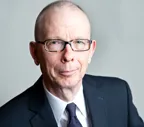Political Scientist Rick Valelly '75 Discusses Significance of President Obama's Support of Gay Marriage

Soon after President Barack Obama announced his support of same-sex marriage, political scientist Richard Valelly '75 discussed the significance of the President's support with Annual Reviews Audio Conversations host Anna Rascouët-Paz. Valelly, the author of "LGBT Politics and American Political Development," recently published in Annual Review of Political Science, also discussed the history of the rights of gays, lesbians, bisexuals, and transgendered people and explained how this movement shaped the landscape of American politics. Listen to their conversation; a partial transcript appears below.
"Before the 1940s, actors in the federal government did not organize and direct anti-gay affect," says Valelly, who recently received a fellowship from the American Council of Learned Societies to do research on his project, Dismantling Straight Government. "But abruptly, from 1941 into the early 1950s, the politicization of homosexuality emerged and was institutionalized in Congress, the armed forces, the White House, and the Civil Service Commission, with far-reaching state and local repercussions. That legacy of exclusions has decisively ended with repeal of Don't Ask Don't Tell. What happened when? Why? And why have the exclusions finally been dismantled now?"
Valelly, the Claude C. Smith '14 Professor of Political Science, is an expert on American party politics, election law, voting rights, and the institutional development of the House and the Senate. He also writes on conceptual and methodological developments and progress within the political science profession. Valelly is the author of The Voting Rights Act (2005) and the award-winning The Two Reconstructions: The Struggle for Black Enfranchisement (2004).
Partial transcript:
Anna Rascouet-Paz (host): You wrote an article included in the 2012 Annual Review of Political Science titled "LGBT Politics and American Political Development." So the first question I have for you is, why did you become interested in LGBT politics?
Richard Valelly: Well, I became interested for two reasons. I have a very strong interest in how political democracy expands, and how rights are won and struggled for. And secondly, also for personal reasons. I have close relatives in my family who are gay. So between my standing intellectual interest and my personal experience, the personal became political science and has been working out very well...
ARP: Right, so, one of the reasons that we're talking to you today is because of this announcement of President Obama's last week [in favor of same-sex marriage]. Is this truly significant? Is this going to be meaningful for the future?
RV: It's significant because of the great symbolism that's involved. That is, when the President of the United States, even though there are lots of people who disagree with the President, and it's not a stance that he's taken that is gaining him an awful lot of personal support. Nonetheless, for LGBT people it's incredibly important to get that kind of recognition. And so it really benchmarks the discussion going forward once the President of the United States comes out in favor in such a dramatic way in favor of same-sex marriage...
ARP: So, let's take a look a little bit of the history of the perceptions of gays, lesbians, bisexuals and more recently transsexuals over the course of America's history. Was it always such a big deal?
RV: No! That's one of the things that I found so surprising when I was doing the research and the writing for this article for Annual Reviews. I discovered that in the 1920s and 1930s, it's not as if lesbians and gays transgendered identifications didn't exist then. But lesbians and gays were openly accepted in the same way, in many of the ways they are now. But there was no intense policing. The closet didn't exist. People didn't have to hide their identity, and there weren't the same sorts of physical dangers that awaited people, what I call the 'sexuality regime' of the Cold War period was put into place. Physical dangers didn't exist. You didn't have to worry about going to a gay bar or lesbian bar and being raided or worry about your safety when you left. And there was real interest in the possibility of diversity in sexual orientation in certain parts of the United States, not everywhere, but in Los Angeles or New York City. So it wasn't politicized. Also the Federal government was not politicizing it. There were state statutes against sodomy, but those statutes were not specifically statutes aimed at homosexual identity. They were sexual practice statutes. They were very rarely enforced. So in some ways it was a comfortable time to be lesbian or gay in the United States in the 1920s and in 1930s. It really wasn't until the Lavender Scare of the 1940s and 1950s that people needed to find a closet for themselves, to find a way to manage other peoples' perceptions of who they were...



